
EMA recommends to continue AZD1222 vaccinations
On Tuesday, Emer Cooke had already hinted at it. Now the EMA's PRAC committee confirmed: the benefits of AZ1222 by far outweigh the risks of the COVID-19 vaccine.
After the stops of AstraZeneca’s COVID-19 vaccine or specific batches of it in 13 EU member states, the EU regulatory authority EMA has analysed the incidence of rare thrombolytic events and potential causal links to the adenoviral vaccine AZD-1222 in the EU. Today, the authority in Amsterdam confirmed what its chief Emer Cooke had already indicated two days earlier: the EMA’s upholds its recommendation that the benefits of vaccination by far outweigh the disadvantages. Previously the World Health Organisation has called on nations to continue vaccinations with AZD1222.
Specifically, the EMA’s PRAC Committee concluded that the vaccine is not associated with an increase in the overall risk of blood clots (thromboembolic events) in those who receive it; and that there is no evidence of a problem related to specific batches of the vaccine or to particular manufacturing sites.
However, the vaccine may be associated with very rare cases of blood clots associated with thrombocytopenia, i.e. low levels of blood platelets with or without bleeding, including rare cases of clots in the vessels draining blood from the brain (CVST).
According to the PRAC committee, around 20 million people in the UK and in the European economic area (EEA) had received the vaccine as of March 16 and EMA had reviewed seven cases of blood clots in multiple blood vessels (disseminated intravascular coagulation, DIC) and 18 cases of CVST mostly occurring within 14 days after vaccination. The authority confirmed statements of AstraZeneca that the overall number of thromboembolic events was lower than expected in the vaccinated population.
The majority of CVST reports is the reason why several nations paused vaccination, involved women under 55, although some of this may reflect greater exposure of such individuals due to targeting of particular populations for vaccine campaigns in different Member States. Furthermore, the number of reported events exceeds those expected, and causality although not confirmed, cannot therefore be excluded. However, given the rarity of the events, and the difficulty of establishing baseline incidence since COVID-19 itself is resulting in hospitalisations with thromboembolic complications, the strength of any association is uncertain.
The review demonstrates that the side effect screening mechanism works very well. Overall, 13 EU states including France, Italy and Germany had temporarily suspended use of the vaccine over fears of a link to CVST. The EMA made clear that it is up to individual countries to decide whether to follow the EMA advice. Italy was the first country to resume vaccination of AZD1222. Germany followed suit because COVID-19 incidence is rising sharply at the beginning of the third wave of SARS-CoV-2 infections.France did not provide any comment but announced lockdowns in several French regions. And Sweden said it would need some days to analyse the EMA’s decision.
It remains, however, to be seen, how effective the EU approved vaccines including AZD-1222 will prevent severe disease courses and deaths after the occurence of viral variants that are both, more contagious and for the B.1.1.7 variant 60% more deadly as only JNJ’s COVID-19 vaccine has been shown to be effective against the mutants SARS-CoV-2 strains under real life conditions.
Fears of now lack of acceptance of the AstraZeneca vaccine in Europe could possibly be allayed by politicians with a simple hint that is more important for Third World countries: AZD-1222 is the only approved COVID-19 vaccine that is provided at cost price – all others cost at least three times more.


 BIOCOM / aminul788 - Adobe Stock
BIOCOM / aminul788 - Adobe Stock Bayer Co.Lab
Bayer Co.Lab